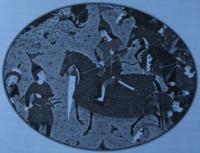Вы здесь
Burial of pseudo Omar.


Tours over historical and architectural monuments of Samarkand.
“Does progress mean that we dissolve our ancient myths? If we forget our legends, I fear that we shall close an important door to the imagination”
James Christensen.
Custom trip in Samarkand.
The monuments represent the most valuable historical material, can significantly complement and enrich the data of written sources. A significant amount of historical information carries the rich architectural heritage of the epoch of Amir Temur and his immediate successors, covering the period from second half of XIV - first half XV century.
The burial of "pseudo Omar" in the crypt of Timur. One of the main places in the Gur-Emir mausoleum is the burial of a certain sheikh or seida "Omar". In the main hall of the mausoleum is the tomb of this rich man occupies the Western niche opposite the entrance of East gallery.
It is outside the common fence, which covers the tombs of the Temurids and seyid Berke. In the crypt the tomb of sheikh "Omar" from the main group of burials punched separate West corridor.
The well-preserved tombstone engraved the arabic text that was read in the 40-ies of the last century, by Semenov A. A. It contains the verses of the Koran and the traditional epithets of Allah, but has no mention of this buried under the stove the person.
At the Western side of the Gur-Emir mausoleum is a huge brick arch, which was part of the architectural complex built here during the reign of Ulugbek. According to archaeological data and the reconstruction of this architectural ensemble has a vast courtyard, the centre of the composition which is the Western entrance to the crypt and window niche of the mausoleum, directly associated with the burial of the sheikh "Omar".
All these facts suggests that there is a burial principal historical person, a religious significance of which was specially stressed by means of architecture during the reign of Ulugbek.
A well-established tradition calls the sheikh "Omar" the fourth son of Emir Kulal al-Bukhari, which was confirmed by the authority of such scholars as V. V. Bartold and V. L. Vyatkin However, A. Semenov drew attention that more detailed information about sheikh Omar is the youngest son of Emir Kulal presented in the work "Manaqib-Amir and Kulal". Here it is reported that Sayyid Omar and the father followed the sufi path.
The greater part of his life he performed the duties of the muhtasib in Shakhrisabz. Died in 803 (1400 - 1401) in a Band-and Okanin, and a year later his remains were moved to Bukhara and buried in the village of Suhari beside his father.
Here A. Semenov concludes that the burial in the Gur-Emir mausoleum cannot be the burial of the son of the emir Kulal and offered to call his burial "pseudo Omar". Contrary to the official version and architecture the original, because then you have to consider the burial of the "pseudo Omar" initial and Amir Temur had to take this into account in terms of the mausoleum.
It is impossible to give convincing reasons that could explain the decision of Ulugbek is to pay unprecedented attention to the figure of the real Omar (son of the Emir Kulal), who did not play according to historical records a significant role in the spiritual and political life of his time.
All this gives grounds to assert the existence of unresolved historical puzzles that require close scientific attention. Looks like we are dealing with the burial of the person whose name is late and Temurides the Sheibanids was consciously forgotten.
This, for example, could be connected with the coming to political power of the "Naqshbandiya" the spiritual attitudes which, as we know, were largely in opposition to the views of Ulugbek.
Historical "calculation" of the person buried in the burial of "pseudo Omar" can significantly change our views on the spiritual atmosphere of the courtyard of Ulugbek. "pseudo Omar" could, for example, be Qasim Anwar (sheikh Amir Mu noddin 'Ali Qasim Tabrizi) who moved to Samarkand in the late 30-ies of the XV century and became the spiritual mentor of Ulugbek.
Until that time, Qasim and Anwar lived in Herat, and had great influence among the nobles of Khorasan. He was expelled from Herat, accused of relations with horrificly, an attempt on the Shah Rukh. This is only version, but you need to look for the shape, scale comparable to that of Qasim Anwar.
Authority:
Alexey Arapov. Samarkand. Masterpieces of Central Asia. Tashkent, Sanat. 2004.







